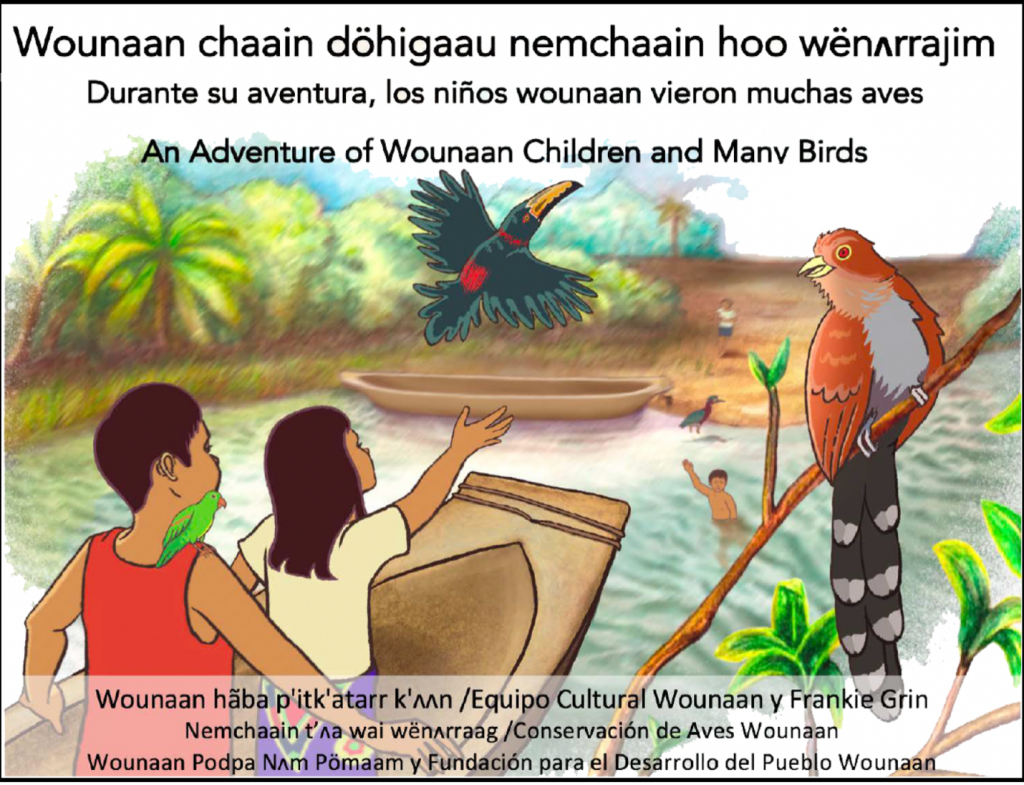The Wounaan National Congress, representing an indigenous people living in Panama and Colombia, invited UGA faculty member Julie Velasquez Runk to help publish a children’s book that celebrates the Wounaan people and their culture history with birds. Shown here are members of the Wounaan Cultural Team that created the book, including (left to right) Doris Cheucarama Membache, Rito Ismare Peña, Runk and Chenier Carpio Opua.
By Alan Flurry
A new children’s book published in three languages focuses on the Wounaan, Indigenous people of Panama and Colombia, and their relationships with birds. A collaborative effort, the book results from two projects supported by the Global Environment Facility and UNDP Small Grants Program and the US-based non-profit Native Future on bird guiding, birds and culture, and forest restoration in Panama. The Wounaan National Congress and the Foundation for the Development of Wounaan People invited University of Georgia faculty member Julie Velasquez Runk to join the project team. Illustrated by UGA graduate Frankie Grin, “The Adventures of Wounaan Children and Many Birds/ Wounaan chaain döhigaau nemchaain hoo wënʌʌrrajim/Los niños wounaan, en sus aventuras vieron muchas aves” launched on November 16.

How the collaboration utilized multi-lingual storytelling in an illustrated children’s book is recounted in an article published recently in the scholarly journal genealogy.
The story book incorporates what the co-authors refer to as ancestors’ stories that are not often told. “We knew that the Wounaan world has changed a lot . . . some practices have already been forgotten, even the forms, the words, the meaning of words . . . already today’s youth have forgotten,” said co-author and Wounaan Chindío Peña Ismare. “We wanted to value, honor, and respect Wounaan lifeworlds with a book for children” the authors’ wrote.

“Our goal was to value Wounaan culture, and those kinds of everyday adventures and relationships the children have – including people bird relationships,” said Runk, associate professor anthropology in the UGA Franklin College of Arts and Sciences who began working in Panama in the 1990’s.
“Over the last twenty years I’ve been working in Panama, the population has transitioned from majority rural to now majority urban, a trend we’ve seen around the world,” Runk said. “So, one of the things we really wanted to do was emphasize how Wounaan society is about that emplaced, embodied knowledge of relationships with people and land, and other beings such as birds.”
The Wounaan are one of seven Indigenous groups in Panama, communities that are facing numerous challenges in relation to recognition and rights to territories. The collaborative project focused on the value of rural life as a foundational identity to the Wounaan as a people.
Originally written in Wounaan meu (the Wounaan language), the team translated the book into Spanish and English. Frankie Grin (BFA, ’20), a UGA alumna of the scientific illustration program in the UGA Lamar Dodd School of Art, translated the narrative into paintings for the publication.
The team’s objective was to value and respect Wounaan lifeworlds by creating materials in Wounaan meu for Wounaan. “We wanted to make materials for children because of the multiple changes that are diminishing Wounaan language and knowing/doing,” the article states.
The study provides extensive background on the collaboration behind the new book and explores the importance of stories to First Nations, Native American, and Indigenous or Original peoples. Throughout Latin America, though stories and storytelling are foundational to cultural identities, grassroots Indigenous scholars often work outside the academy. Often, the resulting publications are local or national, enjoy smaller print runs, and perhaps most crucially are un- or under-indexed on search engines based in the Global North. Open-access digital publishing has expanded the reach of Indigenous stories, of which The Adventures of Wounaan Children and Many Birds is but the latest examples.

